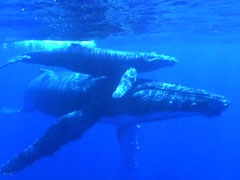Study Goals

Hawaiian waters are critical reproductive habitat for the endangered humpback whale. Two-thirds of the entire North Pacific population of this species goes to these warm waters to breed and calve. Humpback whales emit vocalizations known as “song”, and these sounds have been investigated for decades by many researchers. However, there is a paucity of research on another type of vocalization these whales make – social sounds. These are basically non-song, non-repetitive sounds made by individual animals. Very few studies have been published on these sounds in humpbacks. Most of the studies to date that are available, have focused mainly on surface active groups (vs. other types of pods such as resting pods, mother/calf or mother/calf/escort, and so on).
Cetos researchers have been studying social sounds in humpbacks for many years; we started this specific field of study which is now, over 15 years later, much more common. We have multiple goals under the umbrella of investigating ecological and behavioral parameters associated with social sound vocalizations. We are looking at the variations in these sounds according to several factors. We are especially interested in sounds exchanged between mothers and calves, also known as contact calls . Examining the social bond between mother and calf humpback whales is extremely interesting and a fruitful area for research. Our goal is to provide important information to resource managers about the needs of these animals at a crucial time in their development. We are also focusing on inter-island comparisons and differences found from inshore to offshore.
important information to resource managers about the needs of these animals at a crucial time in their development. We are also focusing on inter-island comparisons and differences found from inshore to offshore.
In the course of our work, we do in-water diving with a variety of recording set-ups that allow us to capture both video and sounds. While collecting data on sounds and behaviors, we also obtain Photo-IDs of humpbacks as well as odontocetes when possible, and we collect annual song samples by tracking and recording singers. You can see some of our underwater footage in our movie short Into the Deep Blue.
